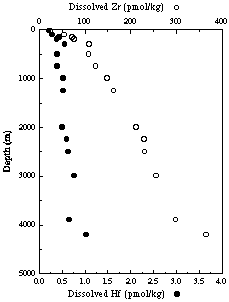
Kristin Orians
Profile
Research and Teaching Interests
The distributions of trace elements in seawater are investigated to better understand the complex biogeochemical cycles operating within the oceans. Measurements of picomolar metal levels in seawater, a complex matrix of 0.5M NaCl and other salts, sampled from ships constructed primarily from metals, is no easy task. This requires advanced separation techniques, the most sensitive elemental-detection methods available, and careful sample handling.

Subartic North Pacific: Station P26 (50°N, 145°W)
Current research is focused on the "particle-reactive" elements in sea-water: Al, Ga, In, Ti, Zr, Hf, Fe, and Mn. These metals are removed rapidly from the oceans via interaction with sinking particles, and have seawater concentrations that vary tremendously with time and space. Their large dynamic range makes them excellent tracers of oceanic processes. Comparing the distribution of the chemically similar, easily hydrolysed elements in the oceans provides information on the chemical controls of seawater composition. Trace elements may also be directly involved in biological processes, either as limiting nutrients or potential toxins. The bioavailability of these elements depends on their chemical form, or "speciation", in the marine environment.
Analytical techniques for the determination of picomolar levels of dissolved metals in seawater are developed. Techniques for total metals typically involve liquid-liquid extractions or chelating column concentration and separation techniques, followed by graphite-furnace atomic absorption spectroscopy (GFAAS) or inductively coupled plasma mass spectrometry (ICP-MS) detection. Detection limits in the low pM range are attained by these techniques. Speciation measurements are performed using a combination of methods: electrochemical methods are used to determine the lability of the metal, chromatographic methods are used to concentrate and separate various metal species and/or the organic ligands which have been found to dominate the speciation of many metals in the surface ocean, and mass spectrometric methods are used to elucidate the structure of these organic ligands.
New techniques are continually under investigation in order to increase sensitivity, facilitate sample handling, or selectively analyse for various metal species. Methods that can be portable, to allow for ship-board determinations, are especially desirable for monitoring contamination at the time of sample collection. Multielemental techniques are also highly desirable.
Contact
Curriculum Vitae
B.A., California, Santa Cruz (1982); Ph.D., California, Santa Cruz (K.W. Bruland, 1988); Postdoctoral, M.I.T. (E.A. Boyle, 1988-89).
